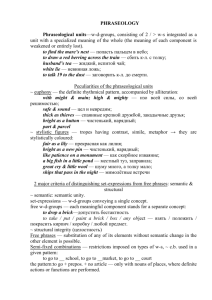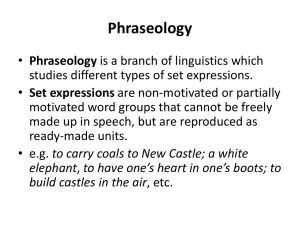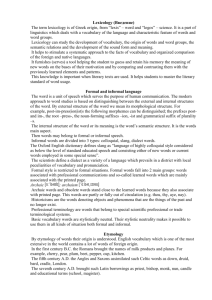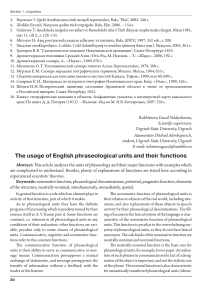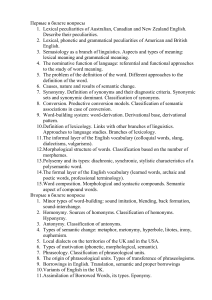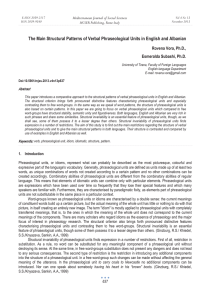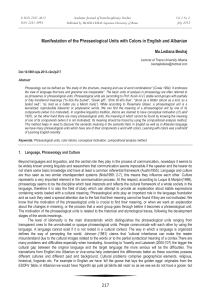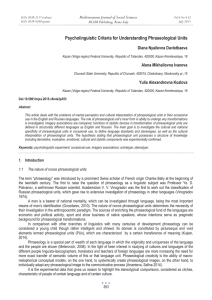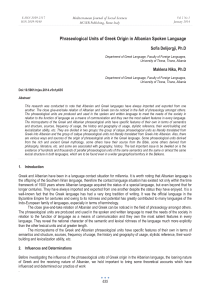Phraseological Units in English: Definition & Classifications
advertisement
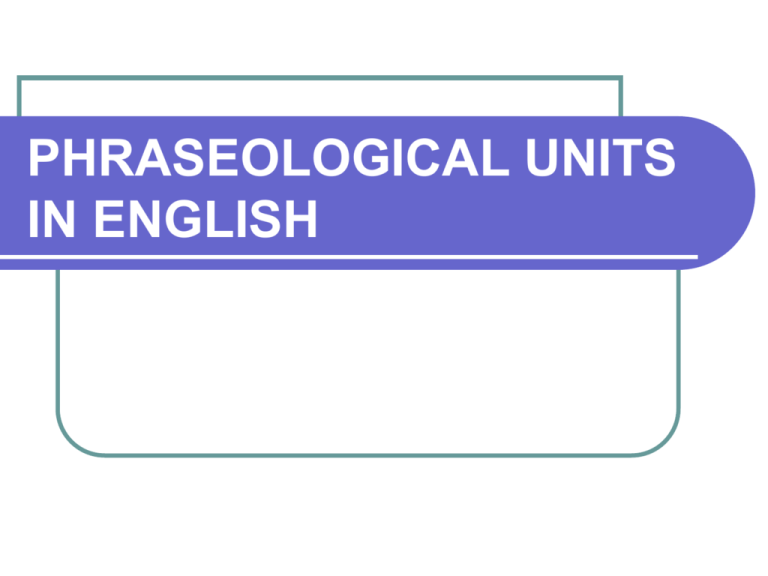
PHRASEOLOGICAL UNITS IN ENGLISH Phraseology as the branch of Linguistics. The problem of terminology Definition of phraseological units. Criteria for phraseologacal units Three approaches towards the study of phraseological units Classification of phraseological units Phraseology as the branch of Linguistics appeared studies in the 1940s phraseological units of the language Object of Phraseology phraseological units, their nature, the way they function in speech Problem of terminology set expression idiom set phrase fixed word-groups word-equivalent phraseological unit Problem of terminology set phrase – implies that the basic criterion of differentiation is stability of the lexical components and grammatical structure of word-groups (I.V. Arnold) Problem of terminology – implies that the essential feature of the linguistic units is idiomacity or lack of motivation (English and American linguists) idiom Problem of terminology – stresses semantic and functional inseparability of certain wordgroups, their aptness to function in speech as single words (A.I.Smirnitstky) word-equivalent Problem of terminology 1. phraseological unit – the most acceptable by Russian linguists phraseological units are not always stable (like set expressions) 2. not always equivalent to one word (like word-equivalents) 3. not always idiomatic (like idioms), may be only partially motivated Phraseological Units non-motivated word-groups cannot be freely made up in speech reproduced as ready-made units structurally stable possess stability of lexical components reproduced as single unchangeable collocations Phraseological Units e.g. red (blue, white, etc) flower BUT red tape ≠ blue tape red flower – red flowers BUT red tape ≠ red tapes Phraseological Units Denotational meaning belongs to a whole phrase as a single inseparable unit e.g. apple sauce - nonsense Connotational meaning belongs to the whole word-group e.g. old boy Phraseological Unit a stable word-group characterized by a completely or partially transferred meaning (A.V. Koonin) Criteria to distinguish free-word groups from phraseological units semantic criterion structural criterion Semantic criterion free word-groupseach meaningful component stands for a separate concept e.g. a red flower phraseological units – convey a single concept e.g. red tape Semantic criterion 1. Phraseological units are characterized by different degrees of semantic change: semantic change may affect the whole word-group (“complete transferred meaning”) e.g. to skate on thin ice (to take risks), to have one’s heart in one’s boots (to be anxious about smth.) Semantic criterion 2. semantic change may affect only one of the components of a word-group (“partially transferred meaning”) e.g. to fall in love, small talk, to talk shop Structural Criterion: restriction in substitution free word-groups – components may be changed e.g. The cargo ship/vessel is carrying coal to Liverpool/ Manchester phraseological units – no word can be replaced without destroying the sense e.g. to carry coals to Newcastle Structural Criterion: introducing additional components free word-groups – change can be made without affecting the general meaning e.g. The big ship is carrying a large cargo of coal to the port of Liverpool phraseological units – no additional components can be introduced e.g. the white elephant – NOT the big white elephant Structural Criterion: grammatical invariability free word-groups – e.g. red flower – red flowers phraseological units e.g. to find fault with smb. NOT to find faults with smb. Features of Phraseological Units semantic and structural stability idiomacity (lack of motivation) ready-madeness the most common structure: verb +object formed from free word combinations Approaches to the Study of Phraseological Units semantic functional contextual Semantic Approach phraseological units are nonmotivated (idiomacity) phraseological units are opposed to free-word combinations which are completely motivated Functional Approach phraseological units are specific word-groups functioning like word-equivalents like words they possess structural and semantic inseparability Contextual Approach phraseological units are used in specific contexts – non-variable, or “fixed” non-variability is a stability of the lexical components within the semantic structure Classifications of Phraseological Units Classifications based on a semantic approach semantic classification - according to the degree of motivation (V.V. Vinogradov) structural classification – based on the ability to perform the same syntactical functions as words structural-semantical classification by A.I. Smirnitsky 1. Classifications of Phraseological Units 2. Classification based on a functional approach structural-semantic classification (A.V. Koonin) 3. Classification based on a contexual approach classification by N.N. Amosova V.V. Vinogradov’s Classification phraseological combinations (фразеологические сочетания) – word-groups with partially changed meaning e.g. to be good at smth., to have a bite, bosom friends V.V. Vinogradov’s Classification phraseological unities (фразеологические единства) – word-groups with completely changed meaning, the meaning of the unit does not correspond to the meanings of its constituent parts, but deducible as it is based on metaphor V.V. Vinogradov’s Classification phraseological unities e.g. to lock the stable door after the horse is stolen (“to take precautions too late”), a fish out of water (‘a person situated uncomfortably outside its usual environment’) V.V. Vinogradov’s Classification phraseological fusions (фразеологические сращения) – word-groups with completely changed meaning, their meaning cannot be deduced from the meanings of its constituent parts V.V. Vinogradov’s Classification phraseological fusions e.g. at sixes and sevens (‘in confusion or in disagreement’) to set one’s cap at smb. (‘to try and attract smb.) R.S.Ginzburg’s Classification fusions – completely non-motivated wordgroups, characterized by the complete stability of the lexical components and the grammatical structure phraseological e.g. to kick the bucket, red tape R.S.Ginzburg’s Classification phraseological unities – partially nonmotivated, the meaning is perceived through the metaphoric meaning of the unit, characterized by high degree of stability of the lexical components e.g. to show one’s teeth, to wash one’s dirty linen in the public R.S.Ginzburg’s Classification collocations – motivated word-groups, have specific lexical valency which results in their stability phraseological e.g. to take a liking/ fancy, to bear a grudge/ malice Structural Classification verbal (verb equivalent) e.g. to catch at a straw substantive (noun equivalent) e.g. dog’s life, white elephant adjectival (adjective equivalent) e.g. safe and sound Structural Classification adverbial (adverb equivalent) e.g. in the twinkle of an eye interjectional e.g. goodness gracious! Dear me! Classification by A.I. Smirnitsky tried to combine structural and semantic principles compared phraseological units with words Classification by A.I. Smirnitsky one-summit (one-top) units – have one meaningful constituent (compared with affixed words) 1. verbal-adverbial units – equivalent to verbs in which grammatical and semantic centers coincide in the first component e.g. to back up – поддерживать to nose out - разузнавать Classification by A.I. Smirnitsky 2. units equivalent to verbs in which semantic centre is in the second element and grammatical centre is in the first element e.g. to be tired Classification by A.I. Smirnitsky 3. prepositional-nominal units – equivalent to unchangeable words: prepositions, conjunctions, adverbs. Semantic center is in the nominal constituent, there is no grammatical center e.g. in the course of – during, o the nose exactly Classification by A.I. Smirnitsky two-summit (two-top) units - have two or more meaningful constituents (compared with compound words) 1. attributive-nominal units - equivalent to nouns e.g. millstone round one’s neck – камень на шее high road - шоссе Classification by A.I. Smirnitsky 2. verbal-nominal units – equivalent to verbs e.g. to read between the lines – понимать скрытый смысл to speak BBC - говорить на правильном английском языке Classification by A.I. Smirnitsky 3. phraseological repetitions – equivalents of adverbs or adjectives, components are joined by a conjunction e.g. back and forth – взад и вперед ups and downs – взлеты и падения multi-summit units e.g. to be a shadow of one’s own self – быть тенью самого себя A.V. Koonin’s Classification based on structural-semantic principle based on the functions units fulfil in speech A.V. Koonin’s Classification according to the function in communication 1. nominative e.g. a bull in a china shop 2. interjectional e.g. a pretty kettle of fish! A.V. Koonin’s Classification according to the function in communication 3. nominative-communicative – verbal word-groups which are transformed into a sentence when the verb is used in the Passive Voice e.g. to break the ice – the ice is broken 4. communicative – proverbs and sayings e.g. spare a rod and spoil a child - пожалеешь розгу, испортишь ребенка; баловством портить ребенка A.V. Koonin’s Classification according to the structure changeable/ unchangeable 1. may have synonyms e.g. to lift a finger – not to raise a finger 2. with a variable pronoun e.g. to pull one’s leg 3. with both types of variability e.g. to give smb a piece/ a bit of one’s mind Classification by N.N. Amosova phraseological units are units of a fixed context fixed context – specific and unchanging sequence of lexical components and specific relations between them Classification by N.N. Amosova – always binory, one component has a phraseologically bound meaning, the other serves as a determining context e.g. small talk, small hours phrasemes Classification by N.N. Amosova idioms – the new meaning is crated by the whole, every element may have its original meaning weakened or completely lost e.g. in the nick of the time – ‘at the exact moment’ movable (changeable)/immovable e.g. apple sauce/ the apple of one’s eye Proverbs (пословица) sum up the collective wisdom of the community, a popular truth or a moral lesson in a concise and imaginative way are metaphorical they moralize e.g. Hell is paved with good intentions Proverbs they admonish e.g. If you sing before breakfast, you will cry before night they criticize e.g. Everyone calls his own geese swans they give advice e.g. Don’t judge a tree by its bark Proverbs lexical components are stable meaning is figurative are ready-made units are easily transformed into phraseological units e.g. don’t cast pearls before swine – to cast pearls before swine Sayings (поговорка) are non-metaphorical, not figurative grammatically they are finished sentences e.g. Where there is a way, there is a will Familiar Quotations (крылатые выражения) come from literature in contrast to proverbs, they do not express finished judgment e.g. To err is human.
